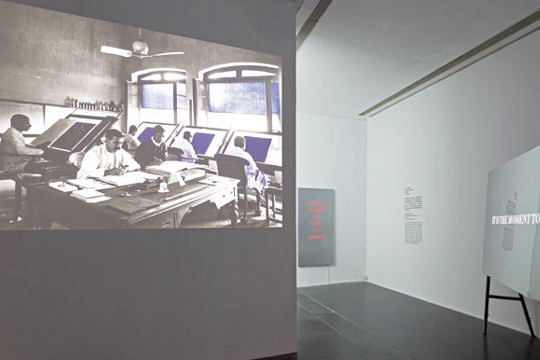MULTITUDE ART PRIZE
| July 19, 2013 | Post In LEAP 21

PHOTO: Luke Walker, courtesy of UCCA
When put forward as a philosophical concept, “the multitude” must find a way for its subjectivity— in the context of new capitalist constructs, like cognitive capitalism, which carry such potential for conspired action and integration—to realize true diversity and differentiation in the “decision” to sustain itself. As compared to the way in which the notion of “the people” has already become a legitimized explanation corresponding to the range of differences contained in the domain of that concept “nation,” “the multitude” instead demands to be the object of much more common and generic functions (such as flesh, language, and so on), moving beyond the grand framework built by dialectic experience and the logic of governmentality—and held in submission by “sovereignty”—and instead turning to the task of unpacking the “political” within each and every microscopic circumstance. The relationship between contemporary art and “the multitude” seems like a balance still longed for: the individual practice emphasized by contemporary art in reality implies a certain subjectivity in a constant process of self-determination; it pursues a characteristic that could be described as “the universal minority” as it attempts to grasp amidst uncertainty its own unschematizable, unpredictable dynamic subjectivity. On the other hand, contemporary art tries internally to open up a space outside the realm of practical interest for political discussion and social experimentation, serving as a platform on which a range of essential questions can be posed and probed.
Stepping back to process the reality, it becomes clear that the force and significance of an award exhibition will inevitably be subject to degradation as a result of friction with concept. First of all, the geopolitical benchmarks delineated by the Multitude Prize doom it to fall into the trap of the classical, politically left-leaning notion of “the masses”: if it is exploring the problem of “the multitude” in the “Asian” context, it may as well be returning to relationship-building in the nation- state sense (the “Multitude Prize” divides the Asian region according to geographical positions, into China, East Asia, Southeast Asia, Central and West Asia, and so on), as it is not truly taking its point of departure from “nation” in terms of the political meaning of life itself. Neglecting this distinction is equivalent to distorting “the multitude’s” emphasis on “the universal minority”— which it seeks to express in its very foundations— and turning instead to a one-sided pursuit of the practical operational convenience of the majority, to the universal, and to one-party identity politics.
Secondly, in the accompanying seminar, the degree to which the institution was discussed seemed to surpass the contemplation of the art itself. The institutional reality of contemporary art is undeniable, but we must note that the ontological significance of these institutions, their transcendent desires, and the network of relationships shared across them are to a certain degree replacing what is truly radical about contemporary art.
For example, on the question of the “plasticity” of the subject and object, the institution has revealed its weakness: on the one hand it is unable to replace the dynamism of “the person,” or the artist, when it comes to the actualization of his knowledge and the bringing to life of his images, and is only able to act as a facilitator or adaptor for this dynamism. But on the other hand, assuming as it does the role of a protective barrier beyond the power of “the person,” when the tension internal to the institution’s “project” grows, in reality it can block or cover up, to a certain degree, the individual energy released in the practice of self-subjectivity.
The exhibition itself has ultimately taken on a supporting role alongside the cacophony of discussion. The whole event is an international smorgasbord, offering a full spectrum of discourse and work from all manner of global backgrounds. In response to the call of “the multitude,” the works assembled overflow with unclear markers and clues: El fin del Mundo, Moon Kyungwon and Jeon Joonho’s much acclaimed work from dOCUMENTA (13), makes use of finely detailed and precise, cinematized reproduction to express its pessimism about the future; Yao Jui-chung’s Mirage: Disused Public Property in Taiwan orders and catalogues the past to gain access to an exit into and way to intervene in the present; and Ha Za Vu Zu’s live performance, a two-person act of human voices, completed a representational articulation of political events. But how did all of these works obtain permission to co-exist in the space of a single exhibition? Their “chosen” status is the inert product of the award-selection mechanism, the outcome of combing through so many complex concepts and attempting to weave together meanings inherent to each work so that, after it is all over, “the multitude” is left only with hermeneutic possibilities.

